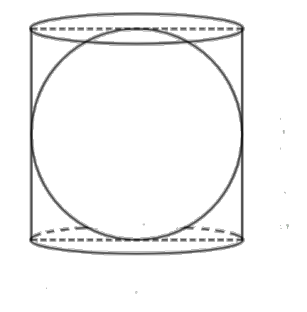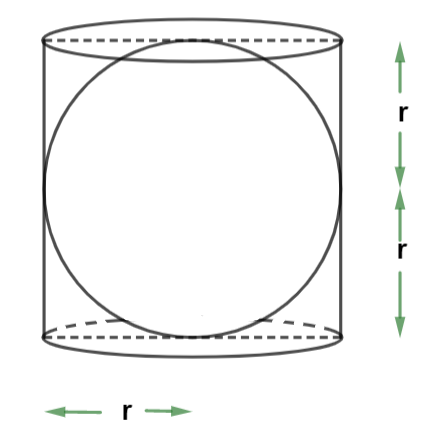NCERT Solutions for Maths Class 9 Chapter 11 Exercise 11.2 - FREE PDF Download
NCERT Solutions for Class 9 Maths Chapter 11 Surface Areas And Volumes Ex 11.2
FAQs on NCERT Solutions for Class 9 Maths Chapter 11 Surface Areas And Volumes Ex 11.2
1. What is meant by the term ‘surface area’ in Class 9 Maths Ex 11.2 Surface Area and Volume?
The surface area of any solid or 3D shape in Class 9 Maths Ex 11.2 Surface Area and Volume can be defined as the sum of the areas of all its sides. It gives a measure of the area that a 3D figure occupies. There is a list of formulas that are commonly used to calculate the surface areas of 3D shapes, in maths. For example, there is a particular formula for calculating the surface area of a cube, whereas there is another formula for calculating the surface area of a sphere, and so on. Also, there are two types of surface areas for some 3D shapes, namely lateral surface area and total surface area, for more information visit Class 9 Maths Ex 11.2 Surface Area and Volume.
2. What is meant by the ‘volume’ of a 3D shape in Maths Class 9 Chapter 11 Exercise 11.2?
According to NCERT Solutions for Class 9 Maths Chapter 11 Exercise 11.2, the volume of a 3D shape or solid is the amount of space occupied by it. The volume of a 3D shape also gives the measure of the matter enclosed within the boundaries of the solid. If we measure the volume of a hollow or empty object, we can get the total volume of air or water that it can hold. Volume can be found only for 3-dimensional objects and not for 2D objects, such as squares or rectangles. In Maths, there are separate formulas to calculate the volume of various 3D objects. For example, the formula to find the volume of a cube is different from the formula to find the volume of a cuboid.
3. How many sums are there in the NCERT Solutions for Class 9 Maths Chapter 11 Exercise 11.2?
There are a total of 9 sums in the NCERT Solutions for Class 9 Maths Chapter 11 Exercise 11.2. Most of the sums in this exercise are based on the concept of surface areas and volumes of spheres and cylinders. When you refer to the solutions of these sums, you will be able to understand that you will have to write statements for solving these sums. All 9 sums are solved and explained step by step in these NCERT solutions for Surface Areas and Volumes, exercise 11.2.
4. Are the NCERT Solutions for Class 9 Maths Chapter 11 Exercise 11.2 helpful?
Yes, the Class 9 Chapter 11 Surface Area and Volume Exercise 11.2 is very helpful for exam preparation. These solutions are prepared by the highly experienced faculty at Vedantu, in a step-by-step manner. Thereby, these stepwise NCERT solutions will guide you to comprehend the concepts of Surface Areas and Volumes for various solid shapes. Therefore, these solutions make a self-explanatory study resource for practice and revision purposes for your exam preparation. Also, you can download these Class 9 Chapter 11 Surface Area and Volume Exercise 11.2 for free from our website as well as from our mobile application.
5. Where can I find the Class 9 Maths Chapter 11 Surface Area and Volume Exercise 11.2?
NCERT Solutions to Class 9 Maths Chapter 11 Surface Area and Volume Exercise 11.2 are available on Vedantu. You can download the Class 9 Chapter 11 Surface Area and Volume Exercise 11.2 PDF free of cost. These NCERT Solutions are available in PDF format on the website as well as on the mobile app of Vedantu. It has helped thousands of students in their learning path and is continuing to do so. These solutions are created by highly experienced faculty and are explained in an easy-to-understand stepwise manner.
6. Is Class 9 Maths Chapter 11 Surface Area and Volume Exercise 11.2 considered the toughest chapter?
No, not really, Class 9 Maths Chapter 11 Surface Area and Volume Exercise 11.2 may be tricky so it requires good practice to understand the concepts covered in this chapter. If you practice regularly and with proper concentration then it will not be a tough chapter. Even if you don’t get the answer on your first try, solve it again, and eventually, you will be able to get the correct answer. You can verify your solutions from the link NCERT Solutions for Class 9 Chapter 11 Maths Exercise 11.2.
7. Can I get help in solving the sums of NCERT Class 9 Maths Chapter 11 Exercise 11.2 from the experts at Vedantu?
Yes, our experts at Vedantu are always ready to make learning easy for you. They try to help you out as soon as possible when you reach out with any doubt. Our subject experts are highly professional and have years of teaching experience. Each expert has a wide knowledge of the specific subject. They will address your doubts and explain the sums to you. So you may post your doubt or get in contact with our experts for guidance in NCERT Class 9 Maths Chapter 11 Exercise 11.2.
8. What makes Vedantu’sNCERT Class 9 Maths Chapter 11 Exercise 11.2 more reliable than other platforms?
Vedantu is one such platform that has a wholesome amount of brand value. It has been working for the best of students' interests and tries to update its platform as per the current education requirement. Queries are easily resolved without any barriers. The content is curated as per the latest format of CBSE. By applying the easy tricks and tips of problem-solving, students can solve the sums in Exercise 11.2 smoothly. Hence, you can download the PDF of NCERT Solutions of NCERT Class 9 Maths Chapter 11 Exercise 11.2 from the Vedantu app or website.
9. Can I prepare for Maths Class 9 Chapter 11 Exercise 11.2 syllabus within one month of time?
In Maths Class 9 Chapter 11 Exercise 11.2, the time required for exam preparation entirely depends on the speed and accuracy of students. For some, one month can be a shorter period while for some it can be long enough. But the sooner the better, so it is advisable, to begin with the chapter as early as you can.
10. What topics are covered in Class 9 Chapter 11 Maths Exercise 11.2?
Maths Class 9 Chapter 11 Exercise 11.2 covers the calculation of surface areas and volumes of various shapes, including cuboids, cubes, cylinders, cones, and spheres. It helps students understand how to use these formulas in different problems.
11. How can understanding surface areas and volumes help in real life from Class 9 Chapter 11 Maths Exercise 11.2?
Understanding surface areas and volumes is useful in many real-life situations, such as calculating the paint needed for a room, the water a tank can hold, or the packaging for products. These skills are practical and widely applicable.
12. What is the formula for the surface area of a sphere in Class 9 Chapter 11 Maths Exercise 11.2?
The formula for the surface area of a sphere is $4\pi r^{2}$, where 𝑟 is the radius of the sphere. This formula helps in calculating the total area covering the surface of the sphere.
13. Why are NCERT Solutions by Vedantu useful for this exercise from Class 9 Chapter 11 Surface Area and Volume Exercise 11.2?
NCERT Solutions Class 9 Chapter 11 Surface Area and Volume Exercise 11.2 by Vedantu is useful because it provides clear, step-by-step explanations for each problem, making it easier for students to understand and apply the concepts. These solutions help students improve their problem-solving skills and perform better in exams.














 Watch Video
Watch Video

















